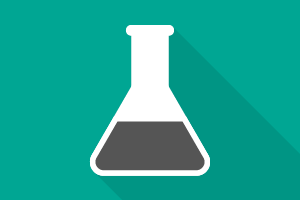Classroom Resources: Atomic Structure
Filter by:
51 – 75 of 83 Classroom Resources
-

Chemical Change, Strong vs Weak, Salts, Mixture, Acid & Base Theories, Conductivity, Ions | Middle School
Lesson Plan: Why Drink Gatorade?
In this lesson, students will test different flavors of Gatorade and other liquids to investigate acids and bases. This will take several days unless students already know about acids and bases.
-

Isotopes | High School
Lab: Isotopes Make Cents
In this lab, students use a sample of pennies to mimic how average atomic mass is calculated.
-

Polyatomic Ions, Review, Ions | High School
Activity: Trade Ions
In this activity, students will learn common ions by creating notecards and quizzing each other.
-

Elements, Model of the Atom, History, Introduction, Matter, Observations, Periodic Table, Culminating Project, Atoms | Middle School, High School
Activity: Is a Picture Worth 1000 Words?
In this activity, students will learn about early chemistry discoveries through a textbook reading as well as from a cartoon.
-

Molecular Formula, Atomic Theory | High School
Activity: Herbal Remedies
In this activity, students learn how the modern atomic theory evolved. They further their understanding of empirical and molecular formulas through research and a presentation of an herbal remedy.
-

Atomic Theory | High School, Middle School
Activity: Scientist Infographic
In this activity, students will design and publish an infographic focused on a well-known scientist and their contribution to the development of the atomic model.
-

Atomic Spectra, Activity Series, Emission Spectrum, Ions, Electromagnetic Spectrum, Emission Spectrum | High School
Lab: Flame Test: Going Further
In this lab, students will investigate the colors produced when several mixtures of metallic ions are placed in a flame.
-

Quantum Numbers, Electron Configuration, Electrons, Orbitals | High School
Lesson Plan: Quantum Numbers
In this lesson plan, students complete a worksheet answering questions regarding quantum numbers.
-

Atomic Theory, Law of Conservation of Energy | High School
Activity: Simulation Actvity: Exciting Electrons
In this simulation, students will explore what happens when electrons within a generic atom are excited from their ground state. This is a qualitative investigation, not meant to mimic any particular atom.
-

Elements, Periodic Table, Interdisciplinary, History, Atoms, Model of the Atom | Middle School, High School
Project: Element Baby Book
In this activity, students will “adopt” an element and create a baby book about their “new baby” while they research and learn about the element.
-

Electrostatic Forces, Subatomic Particles, Electrons, Electricity, Electrons | High School
Lab: Electromagnetic Forces in the Atom
In this lab, students will better understand that opposite charges attract each other, and like charges repel.
-

Electricity, Atoms, Electrons, Electrons, Culminating Project, Interdisciplinary | Elementary School, Middle School
Activity: Electrical Circuit Quiz Box
In this activity, students will learn that the flow of electrons within a closed circuit make our lives easier. Students will construct a circuit quiz box that lights up when the correct question and answer are chosen.
-

Electron Configuration | High School
Activity: E-config Battleship
In this activity, students review electron configurations by using the periodic table like a Battleship board.
-

Atomic Radius, Electron Affinity, Ionization Energy, Periodic Table | High School
Activity: Periodic Trends Investigation
In this activity, students investigate trends in atomic radius, electron affinity, and ionization energy using an online interactive periodic table.
-

Electron Affinity, Atomic Radius, Ionic Radius, Periodic Table | High School
Activity: Periodic Trends II: Electron Affinity, Atomic Radius, & Ionic Radius
In this simulation, students will focus their investigation on the electron affinity of an atom. Through the use of this simulation students will have the opportunity to examine the formation of an anion as well as compare the atomic radius of a neutral atom to the ionic radius of its anion.
-

Atomic Radius, Ionic Radius, Ionization Energy, Valence Electrons, Periodic Table | High School
Activity: Periodic Trends I: Ionization Energy, Atomic Radius & Ionic Radius
In this simulation, students will investigate several periodic trends, including atomic radius, ionization energy and ionic radius. Through the use of this simulation students will have the opportunity to examine atomic data as well as visually compare and interact with select elements from the periodic table.
-

Elements, Model of the Atom, Periodic Table, Introduction, Atoms, Electrons | Middle School, High School
Activity: Periodic Puzzler
In this activity, students will learn about what makes up an atom and how important protons are in the placement of elements on the periodic table.
-

Ionic Bonding, Naming Compounds, Intramolecular Forces, Ions | High School
Activity: Constructing Ionic Compounds
In this activity, students will construct ionic compounds by balancing the charges on cations and anions.
-

Electricity, Energy & Thermodynamics, Law of Conservation of Energy, Anode, Cathode, Electron Transfer, Electrons, Subatomic Particles, Electrons | Middle School
Lesson Plan: Battery Basics
In this lesson students will explore the chemical reaction that occurs within a lead-acid car battery and the role of the battery within a car prior to creating their own batteries.
-

Atomic Spectra, Emission Spectrum, Emission Spectrum, Electromagnetic Spectrum, Interdisciplinary, Identifying an Unknown | Middle School, High School
Lab: Build a Spectroscope
In this lab, the students will make and use a spectroscope to identify the spectra within various types of light bulbs. The students will then develop an improved design for the spectroscope.
-

Atomic Theory, Model of the Atom, Subatomic Particles | High School, Middle School
Simulation: Building an Atom
In this simulation, students manipulate the number of protons, neutrons, and electrons in an element and determine how these effect the mass number, atomic number, and other properties of an atom.
-

Valence Electrons, Lewis Dot Diagrams | High School
Activity: Box Valence Electrons
In this activity, students will create a mini periodic table of elements using Lewis dot diagrams to represent each element up to calcium.
-

Isotopes | High School
Activity: Beanium Isotopes
In this activity, students will determine the average atomic mass of a sample of an imaginary element called Beanium.
-

Model of the Atom, Periodic Table, Elements, Atomic Mass, Electrons, Atoms | Middle School
Activity: Augmented Reality and the Atomic Model
In this project, students will first work with a partner to select a common element from the periodic table to research. They will create a video using iPods to present their research and they will access the Aurasma app on iPods to upload their video. Students will create a trigger image using a picture of the element from the periodic table. Secondly, the students will use the Aurasma App to scan a different element’s trigger image and will use information from another group’s video to construct a model that replicates the atomic structure for the selected element.
-

Atoms, Subatomic Particles, Isotopes, Atomic Theory, History, Elements | Middle School, High School
Activity: Atomic Structure RAFT
In this activity, students choose from a number of activity options in order to best display their understanding of atomic structure. The RAFT model will be followed for this assignment, which means the students choose their assignment and may modify the assignment based on Role, Audience, Format, and Topic.